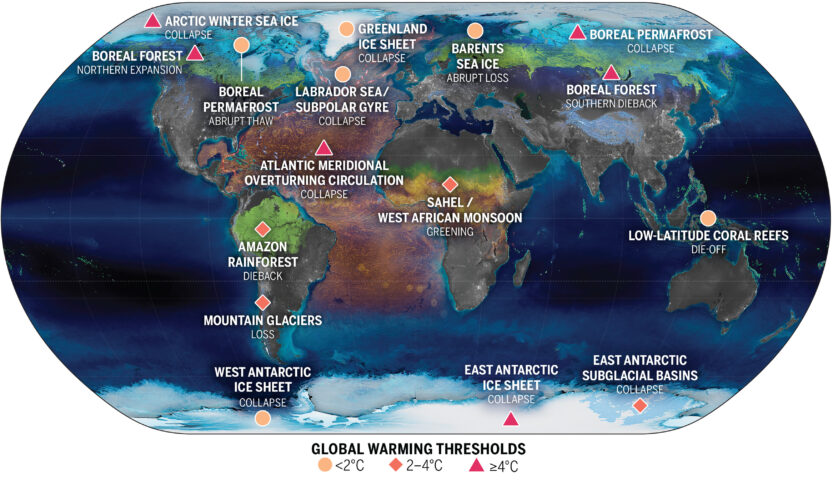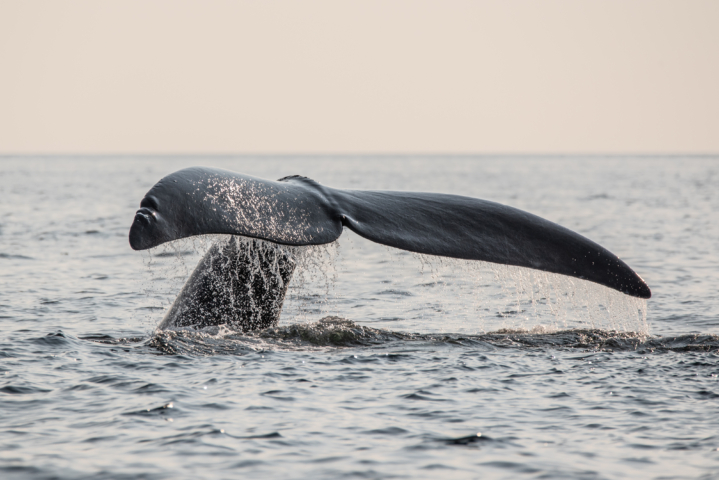Climate Tipping Points, The Labrador Current, And North Atlantic Right Whales
Making the connection between looming climate tipping points and changes we’re already seeing in New Brunswick’s Bay of Fundy
Making the connection between looming climate tipping points and changes we’re already seeing in New Brunswick’s Bay of Fundy
A recent peer-reviewed study says that human activity is dangerously close to triggering multiple ‘climate tipping points’ that will bring about catastrophic consequences on land and sea.
In New Brunswick, our iconic Bay of Fundy waters are already experiencing changes caused by one of these potential tipping points: the breakdown of key ocean circulation systems—in our case, the Labrador Current.
Before we get into that, though, let’s take a brief overview of the study, Exceeding 1.5°C global warming could trigger multiple climate tipping points, published Sept. 2022 in the journal Science.
The paper identifies and assesses nine global ‘core’ systems that, when balanced, are essentially responsible for the Earth being the hospitable, life-supporting planet that it is. The paper also looks at seven regional systems that are particularly important for human welfare.
The authors find that both the global and regional systems are approaching climate tipping points, some, the authors say, will be triggered at 1.5°C warming, others at 2°C and beyond.
Climate tipping points are defined as changes to large parts of the climate system that become self-perpetuating—so, human activity unbalances these systems to the point where the systems themselves spiral further out of control, triggering even more tipping points and spelling cascading catastrophe for people, plants and animals.

We aren’t there yet, but it is absolutely time to take action: check out our climate solutions portal to see what governments, businesses and people can do to slow climate change.
As we mentioned earlier, New Brunswick has, unfortunately, had a front row seat to changes in one of these global climate systems: the Labrador Current.
The Bay of Fundy was long a seasonal stop on North Atlantic right whale migration. The whales came here to socialize, mate, and, most importantly, eat.
The food they rely on is a copepod, a crustacean (related to crab, lobster, and krill), that—you guessed it—hitched a ride on the Labrador Current into the Bay of Fundy where they fattened up just in time for right whales to come and feed on them.
In the past decade or so there have been years with few copepods in the Bay of Fundy or years where the copepods were in the bay, but didn’t have enough to eat themselves so made poor quality food for right whales.
A likely major factor in the decline of copepods, by the way, is rising water temperature in the bay and throughout their migration route—sadly what we can only expect more of, as the Bay of Fundy and Gulf of Maine are among the fastest-warming water bodies on Earth.
Without food to eat in the Bay of Fundy, right whales have ventured elsewhere in larger numbers, like the Gulf of St. Lawrence, where they have come into contact with large vessels and rope, leading to alarming deaths and injuries.

Sadly, the plight of the right whales, and the struggle to find and protect the whales, are the kind of challenges we expect to see more of as marine life adapts to a changing ocean. As water warms, cold water species either die or move north or to deeper water, and new species move into regions. It will take time to develop a new balance—if we’re lucky.
The ocean is a delicate balance, and large systems like those of which the Labrador Current is a part, play a huge role in our lives. These systems move water, nutrients, and animals around the ocean. They affect our weather patterns, temperature, and the many species that rely on particular habitats in the ocean. When their balance is tipped by human activity, it can spell disaster for life as we know it on land and sea.
The report’s authors are blunt in what their scientific assessment means: if we don’t act urgently to slow climate change, then we risk crossing multiple tipping points that in turn can spiral and trigger more tipping points.
We aren't there yet, but it is absolutely time to take action
Matt Abbott, Fundy Baykeeper Tweet
The authors say that even the Paris Agreement goal of limiting warming to well below 2°C, preferably 1.5°C, isn’t enough to prevent the crossing of multiple tipping points. Right now, we’re on pace to hit 2°C to 3°C warming. Our best case scenario, if all current net zero pledges and global climate commitments are implemented, could limit warming to just below 2°C.
The science is clear: we need to do more. We all have a role to play. We need to drastically change the way we power our lives and the way industries operate across the world. And we need citizens, people like you, to stand up and speak out to demand we make these changes.
We’re here to help you speak up. Here’s how:
- Use our letter-writing tool to tell the government you want an affordable, reliable and renewable electricity system.
- Learn about how we can achieve a 100 per cent renewable electricity system in New Brunswick and across Atlantic Canada.
- Learn more about the causes of climate change, and climate solutions, in New Brunswick.
Learn more about Marine Conservation in N.B.
Learn more about Marine Conservation in N.B.
Share this article with your friends and family
